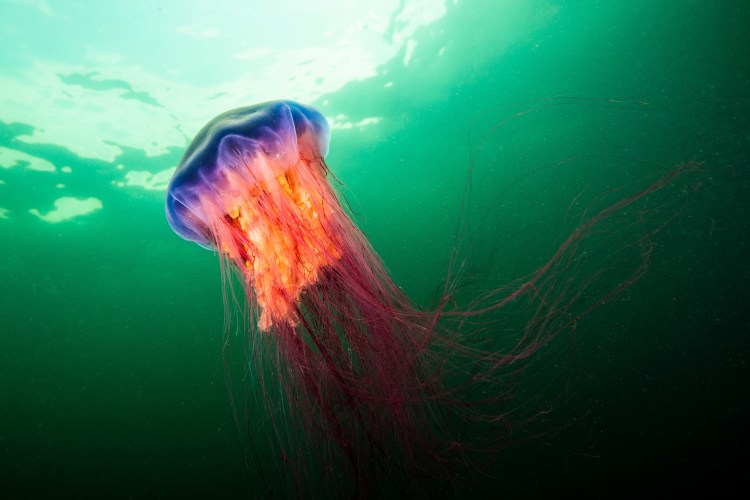Willard Beach received a special summer visitor over the weekend: a 5-foot-wide lion’s mane jellyfish that washed ashore at the popular South Portland destination.
That jellyfish was one of an increasing number that Mainers have reported on or near the shore in recent weeks, prompting warnings of caution from officials and experts.
The city of South Portland advised beachgoers to avoid touching the lion’s mane jellyfish — which drifted back to sea by itself shortly after its discovery — and to contact lifeguards if another one appeared. According to a post on the city’s Instagram account, lifeguards have been instructed to deal with jellyfish by scooping them up with a shovel and moving them back into the water.
View this post on Instagram
Nick Record, a researcher at the Bigelow Lab for Ocean Sciences who tracks jellyfish sightings in Maine, said that while the jellyfish at Willard Beach was the largest of its kind found on land in Maine so far this summer, there have been many other reports of jellyfish stinging humans or being spotted near land recently. So far this year, he said, the vast majority of sightings have been lion’s mane jellyfish, which is one of the largest species.
“They seem to have arrived pretty quickly, just within the last couple weeks,” Record said. “This is definitely a standout year. In most years, we don’t get big ones like the one that washed up on Willard Beach.”
Jellyfish aren’t new to Maine’s aquatic ecosystem, but their behaviors vary drastically, Record said. Some years, there are none to be found, but in others — such as this year — they seem to appear everywhere.
“There’s a lot of different factors that mean we see them closer to shore, and there are other factors that allow them to grow larger,” Record said. “I don’t know specifically which of those factors are contributing right now.”
In the years that jellyfish do appear more regularly, the timeline varies, Record said. While they often show up in the summer, there is no telling at what point they will make their debut — all that humans can do is to keep an eye out.
“We were out in the boat (Wednesday) morning and saw six or eight. … I don’t recall the last time we’ve seen this many,” Ogunquit fire Chief Russell Osgood said. “I’ve been here for four years, and this is the first time I’ve seen this many.
“It used to be sporadic, but it seems like this year, there’s just so many more.”
At Ogunquit beaches, lifeguard stands display colored flags to warn beachgoers of the possibility of jellyfish in the water. While a green flag signifies that water conditions are safe, a purple one denotes that hazardous marine life may be in the area.
“Don’t swim if you see them in the water — stay away from them,” Osgood warned. “It’s a big ocean. We can share it.”
While jellyfish stings are usually painful to humans, it is rare for the sting to be lethal.
“People are saying when they do get stung, it’s pretty painful for 15 minutes or so,” Osgood said. “The only concern I would have is somebody having an anaphylactic reaction to it. If somebody notices that they’re getting hives or they’re short of breath or anything like that, they need to get a hold of 911.”
The lion’s mane jellyfish looks like a reddish-purple blob and has, on average, 1,200 tentacles.
“They’re a pretty fascinating and amazing group of animals,” Record said. “Lion’s manes can be some of the longest animals in the world. They can grow about as long as a blue whale — or longer.”
The average blue whale is 98 feet long, while the tentacles of the lion’s mane jellyfish can reach 120 feet.

To track jellyfish data, Record and the Bigelow Lab for Ocean Sciences, along with the Gulf of Maine Research Institute, created a jellyfish forecast to learn more about their patterns in the Gulf of Maine.
“In 2014, there were some similar large aggregations of jellyfish,” Record said. “At the time, nobody was collecting any data on jellyfish in coastal Maine.”
When visitors to Maine beaches see a jellyfish — of any size or species — they can email a picture and description to [email protected]. From there, Record marks the specific locations of sightings to glean some insight into the patterns.
We invite you to add your comments. We encourage a thoughtful exchange of ideas and information on this website. By joining the conversation, you are agreeing to our commenting policy and terms of use. More information is found on our FAQs. You can modify your screen name here.
Comments are managed by our staff during regular business hours Monday through Friday as well as limited hours on Saturday and Sunday. Comments held for moderation outside of those hours may take longer to approve.
Join the Conversation
Please sign into your CentralMaine.com account to participate in conversations below. If you do not have an account, you can register or subscribe. Questions? Please see our FAQs.